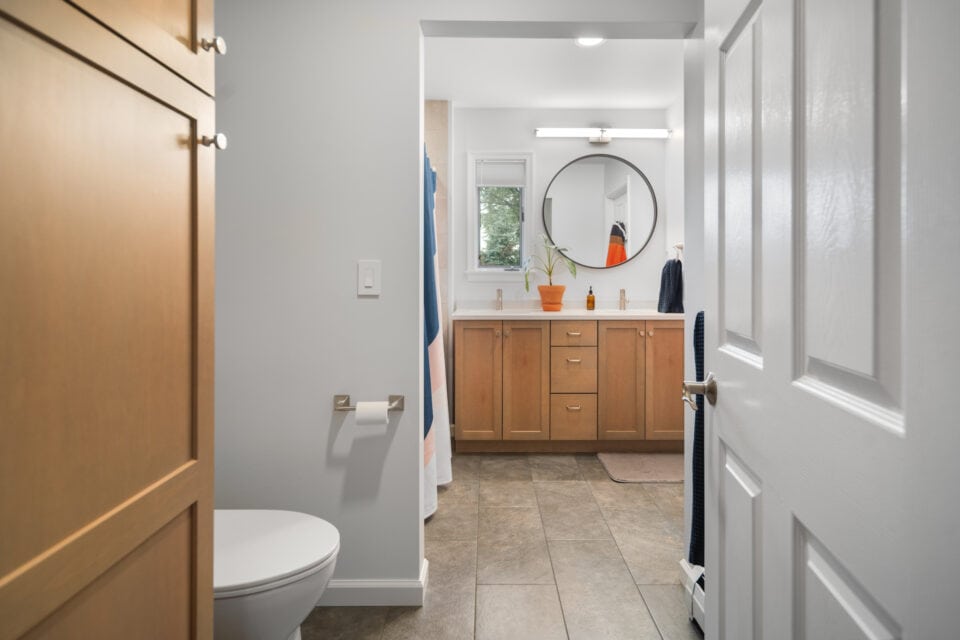Your decision will have far-reaching impacts on the project’s design, timeline, cost, and overall management. I want to help you understand the key differences and benefits of each approach, enabling you to make an informed decision that aligns with your project goals.
Key Takeaways
- Choosing between an architect and a design-build firm for a renovation project depends on your needs, with architects specializing in tailored designs, and design-build firms providing custom design, plus an integrated, efficient process with potential cost savings.
- While architects craft personalized designs and detailed construction documents, they usually do not engage in detailed cost estimation during the design phase.
- Hiring an architecture firm followed by a general contractor puts the emphasis on creative results but can be less efficient due to the segmented nature of the approach. In contrast, design-build firms typically streamline the process, reducing project timelines and costs by up to 20 percent.
The First Step in a Remodel Is Choosing Your Team
It may seem like the most important decisions in a remodel are about floor plans, paint colors, and cabinetry. But before you can get into any of the fun design ideas, it’s crucial to choose the right kind of firm to hire.
One of the first choices you’ll be presented with is whether to start looking for an architect. Hiring an architecture firm or interior designer is the approach most homeowners think of when they consider a major home renovation. It’s a good idea to talk to dedicated architects and interior designers, but don’t limit your search just to these types of designers. You may also want to consider design build firms.
Selecting a team for your renovation project requires an understanding of the difference between hiring an architecture firm and selecting a design-build firm. Let’s first cover definitions and then weigh the pros and cons of each approach.

What Does an Architect Do?
Primarily, architects are responsible for creating building designs that comply with legal regulations. They bring their expertise to every stage of the design process, from initial schematic designs to the detailed preparation of construction drawings and documents. Beyond just drafting plans, architects can also be involved in project management. If you engage them for this, they can help you navigate through bid negotiations and bidding processes and help ensure that the project aligns with your vision and budget. Once construction begins, an architect can provide ongoing oversight to ensure that the work adheres to their designs and meets contractual obligations. They also offer technical guidance on aspects like materials and layout selections, ensuring the project’s successful completion.
Are All Building Projects Designed by an Architect?
The answer is a resounding no. Some architects specialize in residential projects, but many choose to work in the commercial field. The fact is, most residential projects are designed by an interior designer or some other design professional. For their more complicated designs to be approved by the permitting authority, designers sometimes collaborate with other professionals, such as structural engineers. This is especially the case for major structural renovations and new construction. In many other respects, an interior designer can play the same role as an architect.
Pros of Working with an Architect
- Customized Design: Licensed architects specialize in tailoring remodeling plans to meet specific homeowner needs and preferences. Their primary focus is on design, and they often excel at this task. Certain architecture firms have a reputation for cutting-edge or award-winning designs.
- Professional Proficiency: Architecture firms should collectively have a high level of expertise, ensuring compliance with regulations and aesthetic appeal.
- Project Oversight: If you opt to pay for additional services, an architect can offer supervision during the construction phase, checking the work of your general contractor and promoting adherence to the original vision and quality standards.
Cons of Working with an Architect
- Increased Costs: Because architects aren’t directly collaborating with builders on your project, they may specify materials or methods that are uncommonly difficult or expensive to build.
- Inaccurate Expense Estimates: Because most architects don’t incorporate detailed building price estimation into their process, there is a very real chance that the design they come up with will exceed your construction budget once you start sending it out for bids from general contractors.
- Communication Gaps: Since your architect and contractors are not on the same “team,” there is a risk that they won’t have the best communication, leading to project delays or misunderstandings.
- Potential for Discrepancies: A lack of clarity in plans or documentation can cause issues during construction. This can lead to both parties—architect and general contractor—blaming the other for cost overruns or other unexpected outcomes.

A Different Approach: Design Build
Design-build firms streamline home building and renovation by offering an all-encompassing service that combines design, construction, and project management under one roof. Unlike architectural firms that primarily focus on the design aspect, design-build firms bring together a diverse team of professionals. This team typically includes architects or interior designers, estimators, project managers, carpenters, and sometimes tradespeople, each bringing their own expertise to the table.
Pros of Working with a Design-Build Firm
- You Only Have to Find One Firm You Love: Vetting and hiring professionals is not easy, and to properly evaluate them, it takes some time. By choosing design-build, you only have to do it once rather than twice (once for an architect and once again for your general contractor).
- Streamlined Process: The integration of design and construction phases under one contract simplifies project management. The handoff from design to construction is seamless.
- Cost Efficiency: Because design build firms are very aware of real-world building costs, they tend to design projects that are more cost-effective to build. Their streamlined, integrated approach tends to keep overhead lower, leading to lower project costs.
- Single Point of Responsibility: With one firm managing all aspects of the project, communication, billing, and project management are less complex for the client.
- Enhanced Communication: Design build firms are known for having better coordination between the design and construction teams, leading to fewer misunderstandings. Architects traditionally have a more adversarial relationship with building teams, having been hired by the client to check the builder’s work. There is a tendency to point fingers rather than work efficiently and harmoniously.
- Time Efficiency: Projects can often be completed faster due to the elimination of delays typically caused by separate design and construction phases.
Cons of Working with a Design-Build Firm
- Limited Customization: Potential for less tailored designs compared to working with a dedicated architectural firm.
- Less Focus on Individual Elements: Might not emphasize specific design details as much as an architect-led approach.
- Perceived Lack of Control: Some homeowners might feel they have less input in the design process compared to working directly with an architect, although this is usually not the case when the design build firm has designers on staff rather than contracting out design tasks.

Cost Implications: Architect vs Design Build
When it comes to budgeting, material selections, and creating a design that is affordable to build, the design-build approach usually comes out ahead. Homeowners generally save money compared to hiring both architects and contractors separately. Design build firms often offer a cost advantage of up to 20 percent according to some estimates. A potential limitation is that you don’t have an architect in a more adversarial oversight role during the construction phase. If you have an incredibly complex project that needs an eagle eye checking the work of your builders, hiring your architect to oversee the construction phase may make sense.
Communication and Collaboration
Opting for a design-build firm can significantly streamline communication during a renovation project. These firms excel in maintaining open, ongoing dialogue and rapidly resolving issues, reflecting their dedication to the project’s success. Everyone is on the same page. In contrast, working with an architect often involves coordinating interactions among various parties such as contractors, vendors, and city officials, which can complicate communication.
Design-build companies centralize the management of the project, handling everything from initial discussions to addressing construction challenges as they arise. This ‘one-stop-shop’ approach simplifies the renovation process by eliminating the need for multiple external communications. By reducing the involvement of third parties, design-build firms foster more efficient communication flows and minimize potential delays or complications that could arise from external influences during the project’s progression.
Project Timeline and Efficiency
The choice between hiring an architect or a design-build firm may have a substantial impact on your project’s timeline and overall efficiency. Design-build firms often deliver projects more swiftly, thanks to their integrated approach. This method combines various phases of the project under one umbrella, in contrast to the traditional architect-led process, which separates design and construction into distinct phases. While architect-led projects may offer greater creative freedom, they typically require more time to complete.
Design-build firms excel in enhancing efficiency by reducing delays and mitigating issues that stem from miscommunication or disjointed coordination between different teams. By merging design and construction services, these firms simplify and streamline the entire process. This integration not only accelerates the project timeline but also maintains consistency and continuity from the initial design phase through to completion. As a result, the design-build approach often leads to a smoother, more cohesive project execution compared to the classic methods managed by an independent architect or firm.
Final Thoughts
When faced with the decision of hiring an architect versus choosing a design-build firm for your home renovation, it’s crucial to weigh your priorities in design, budget, and process efficiency. Each approach has its advantages and drawbacks. If you value a more bespoke or avant-garde design and are willing to navigate the complexities of managing separate entities, an architect might be your preferred choice. On the other hand, if you are seeking cost-effectiveness and a streamlined experience from conception to completion, a design-build firm could offer the most benefits.
If you are contemplating a remodel in the Ithaca, NY, area, feel free to get in touch. We would be happy to discuss your remodeling plans and answer any questions you might have about the design build process.





